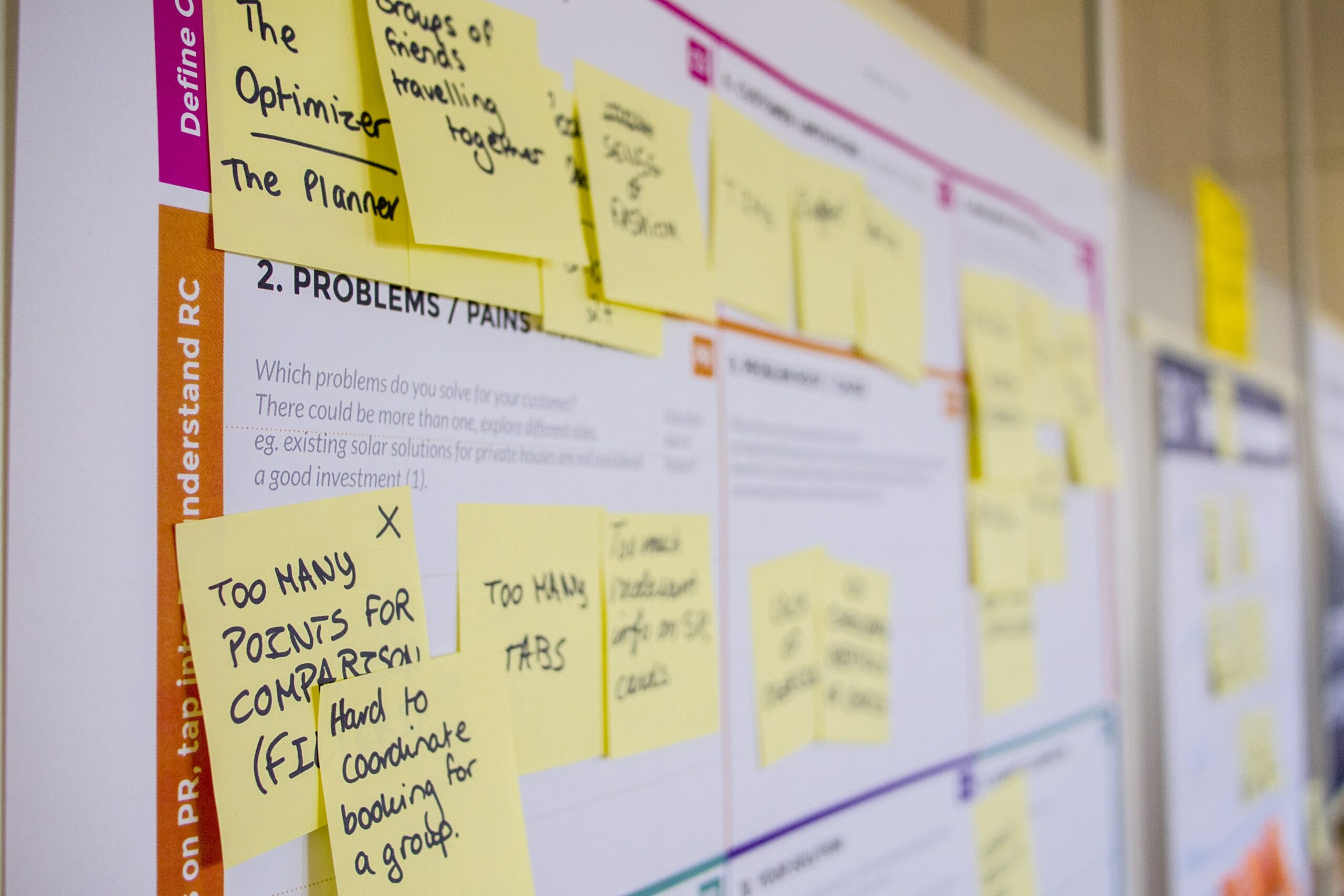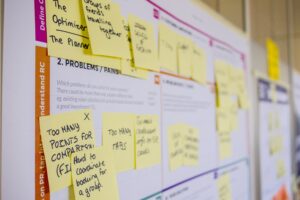In today’s competitive business landscape, it is essential to have a well-defined business model that enables customer discovery, drives innovation, and fosters growth. However, creating a business model from scratch can be daunting, especially when you have to consider various factors, such as customer segments, revenue streams, cost structures, and partnerships.
This is where the Business Model Canvas (BMC) comes in handy. It is a widely popular tool used by entrepreneurs, startups, and established businesses to design, refine, and communicate their business models effectively. In this article, we’ll dive into the foundation of the Business Model Canvas, the building blocks that make it up, and how you can use it to facilitate customer discovery.
What is the Business Model Canvas, and why use it?
The Business Model Canvas (BMC) is a powerful tool that has revolutionized the way businesses approach strategic planning. Developed by Alexander Osterwalder and Yves Pigneur, the BMC is a one-page template that helps businesses visualize, analyze, and design their business models. It comprises nine building blocks covering areas such as customer segments, value proposition, revenue streams, cost structure, and key resources. The BMC template provides an intuitive, standardized approach to defining a business model and allows businesses to focus on the most important aspects of their ventures.
But why should businesses use the BMC? What benefits does it offer?
Understand your customers and their needs better
One of the key benefits of using the BMC is that it helps businesses to gain a deeper understanding of their customers and their needs. By identifying your target customer segments and analyzing their pain points, desires, and behaviors, you can develop a more effective value proposition and tailor your products or services to meet their specific needs. This can lead to increased customer satisfaction, loyalty, and retention.
Identify potential revenue streams and costs effectively
The BMC also helps businesses to identify potential revenue streams and costs more effectively. By mapping out your key activities, resources, and partnerships, you can identify areas where you can reduce costs and increase efficiency. You can also identify new revenue streams and business models that you may not have considered before.
Uncover strategic opportunities for growth and innovation
Another benefit of using the BMC is that it can help businesses to uncover strategic opportunities for growth and innovation. By analyzing your key partners, channels, and customer relationships, you can identify areas where you can innovate and differentiate yourself from your competitors. This can help you to stay ahead of the curve and remain competitive in your industry.
Align team members and stakeholders around a shared vision
Finally, the BMC can help businesses to align team members and stakeholders around a shared vision. By creating a visual representation of your business model, you can communicate your strategy more effectively and get everyone on the same page. This can lead to increased collaboration, productivity, and motivation.
In conclusion, the Business Model Canvas is a powerful tool that can help businesses to visualize, analyze, and design their business models. It offers a range of benefits, from gaining a deeper understanding of your customers to uncovering strategic opportunities for growth and innovation. If you’re looking to take your business to the next level, the BMC is definitely worth considering.
The 9 Building Blocks of the Business Model Canvas
The Business Model Canvas is a strategic management tool that allows businesses to describe, design, challenge, invent, and pivot their business model. It comprises nine building blocks, each of which plays a vital role in defining a robust business model. Here’s a brief overview of each of them:
1. Customer Segments
The customer segments block is the foundation of the Business Model Canvas. It defines the target audience that your business will serve. It should include a clear description of your ideal customers, their demographics, pain points, and how your product or service solves their problems.
For example, if you are a healthcare startup, your customer segments may include patients, doctors, hospitals, and insurance companies. You need to understand the needs of each customer segment and tailor your value proposition accordingly.
2. Value Proposition
Your value proposition defines the unique benefit that your product or service offers to your customers. It answers the question: “What problem does your product or service solve, and what makes it stand out from the competition?”
For example, if you are a software company, your value proposition may be that your product is easy to use, affordable, and saves time for your customers. You need to clearly articulate your value proposition and make sure it resonates with your target customers.
3. Channels
The channels block describes the ways that you will reach your customers and deliver your value proposition. This can include distribution channels, advertising strategies, and other communication methods.
For example, if you are an e-commerce startup, your channels may include social media, email marketing, and search engine optimization. You need to identify the most effective channels for your business and optimize them for maximum impact.
4. Customer Relationships
This building block outlines the type of relationship that you want to establish with your customers. It should consider the level of customer support, customer service, and other factors that will affect your customer satisfaction and retention.
For example, if you are a subscription-based business, you need to focus on building strong relationships with your customers to reduce churn and increase lifetime value. You need to understand the needs and preferences of your customers and tailor your customer relationships accordingly.
5. Revenue Streams
The revenue streams block defines the sources of income that your business will generate. This can include product sales, subscription fees, advertising revenue, and other monetization models.
For example, if you are a media company, your revenue streams may include advertising, sponsorships, and subscriptions. You need to identify the most profitable revenue streams for your business and optimize them for maximum revenue.
6. Key Resources
This block defines the essential resources that your business requires to operate successfully. This can include physical, financial, intellectual, and human resources.
For example, if you are a manufacturing company, your key resources may include raw materials, manufacturing equipment, and skilled labor. You need to identify the key resources that your business requires and optimize them for maximum efficiency.
7. Key Activities
The key activities block outlines the critical tasks and processes that your business needs to execute to deliver your value proposition and generate revenue.
For example, if you are a software company, your key activities may include product development, marketing, and customer support. You need to identify the most critical activities for your business and optimize them for maximum impact.
8. Key Partnerships
This building block defines the strategic partnerships and alliances that your business will need to succeed. This can include suppliers, distributors, and other stakeholders.
For example, if you are a logistics company, your key partnerships may include shipping companies, customs brokers, and insurance providers. You need to identify the most critical partnerships for your business and optimize them for maximum value.
9. Cost Structure
Finally, the cost structure block outlines the costs associated with running your business. This can include fixed and variable expenses, such as salaries, rent, materials, and inventory.
For example, if you are a service-based business, your cost structure may include salaries, office rent, and marketing expenses. You need to identify the most critical costs for your business and optimize them for maximum efficiency.
By understanding and optimizing each of these nine building blocks, you can create a robust and sustainable business model that delivers value to your customers and generates revenue for your business.
How to Effectively Use the Business Model Canvas to Facilitate Customer Discovery
The Business Model Canvas (BMC) is a powerful tool for entrepreneurs and startups to visualize and develop their business model. It is a one-page framework that helps you break down your business into key components, such as customer segments, value proposition, channels, revenue streams, and cost structure. Creating a BMC can be done using pen and paper, but the Discovery Platform was built so you can integrate your customer discovery findings with your canvas.
However, simply creating a BMC is not enough. To truly leverage the power of this tool, you need to use it to facilitate customer discovery. This means using the BMC to test and validate your assumptions about your target market, value proposition, and business model. Here are some best practices for using the BMC to facilitate customer discovery:
- Start with your customers: The first step in using the BMC for customer discovery is to define your customer segments and understand their needs and behaviors. Who are your target customers? What are their pain points and challenges? What motivates them to buy? By answering these questions, you can create a customer profile that will guide your business model.
- Create a clear value proposition: Once you have defined your customer segments, the next step is to develop a compelling value proposition that resonates with your customers and differentiates your business from the competition. Your value proposition should clearly communicate the benefits of your product or service and why customers should choose you over other options.
- Validate your assumptions: After you have created your BMC and developed your value proposition, it’s time to test and verify your assumptions with real customers. This means getting out of the building and talking to potential customers to see if there is a market for your product or service. You can use surveys, interviews, and other feedback mechanisms to collect data and validate your assumptions.
- Iterate and refine: Finally, it’s important to continuously refine your business model by testing different hypotheses, adjusting your value proposition, and analyzing customer feedback. This means being open to feedback and willing to pivot your business model if necessary. By iterating and refining your BMC, you can create a business that truly solves real problems and generates sustainable revenue.
By using the BMC to facilitate customer discovery, you can gain a deeper understanding of your customers and build a business that solves real problems and generates sustainable revenue. Don’t be afraid to experiment, test, and iterate until you find the right product-market fit. With the right approach, the BMC can be a game-changer for your startup.
Alternatives to the Business Model Canvas
While the Business Model Canvas is a widely popular tool for defining a business model, it is not the only one. Other alternatives include the Lean Canvas, the Value Proposition Canvas, and the Mission Model Canvas.
Each of these tools has its strengths and weaknesses, and choosing the right one will depend on your specific needs and circumstances. However, the Business Model Canvas is a great place to start for businesses that are just getting started or looking to refine their existing business models.
Benefits of Using Software to Track the Business Model Canvas
Using specialized software to track your BMC can provide several benefits, including:
- Improved collaboration and communication among team members and stakeholders
- Centralized and accessible data that enables real-time updates and analysis
- Customizable templates that allow you to tailor the BMC to your specific needs and industry
- Integration with customer discovery interviews and instructor feedback.
The Discovery Platform has everything you need to set up your canvas, interview potential customers and stakeholders, and collaborate with mentors, instructors, and other innovators.
Conclusion
The Business Model Canvas is a versatile and powerful tool that enables businesses to design, refine, and communicate their business models effectively. Whether you’re a startup or an established business looking to drive growth and innovation, the BMC can help you understand your customers better, identify potential revenue streams, and build a sustainable business model. By following the best practices outlined in this article and leveraging The Discovery Platform, you can unlock the full potential of the Business Model Canvas and facilitate customer discovery like never before.








